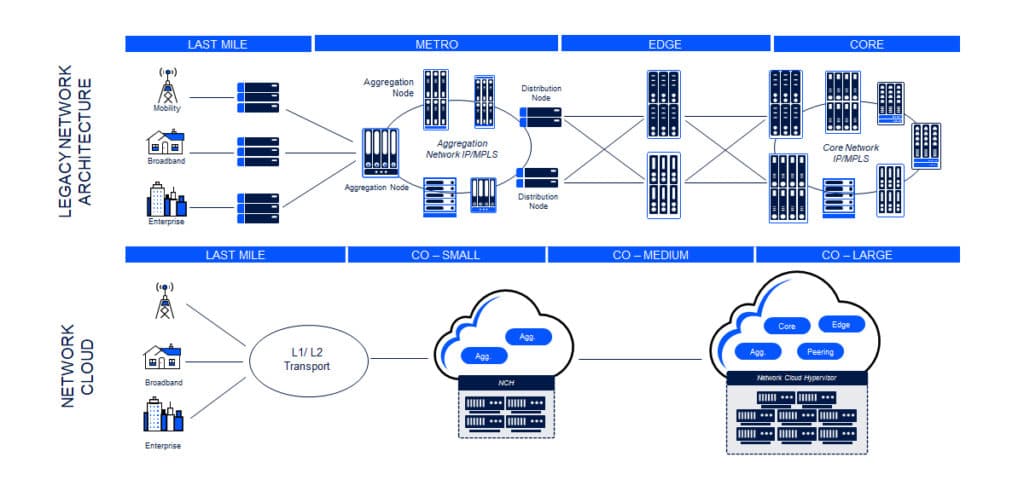Improve Cost Structure
The cost structure of legacy networks is difficult, to say the least. The legacy chassis-based pricing model for networking routers is based on perpetual licenses for hardware components (including chassis, router processors and capacity-based line cards) while software is sold as perpetual or time-based licenses per port.
One problem of the legacy model is that service providers usually have multiple networks built upon dedicated proprietary hardware typically provided by multiple vendors. Multitudes of different network-specific hardware devices, whose costs grow linearly with growing traffic demand, lead to a poor cost structure. Moreover, these devices cannot share their resources, leading to poor resource utilization. In addition to network routing devices, a typical network architecture includes some non-routing functions (such as firewalls), which require purpose-built hardware appliances.
DriveNets Network Cloud runs and manages networks as a shared resource, leading to significant cost savings through economies-of-scale and higher resource utilization.
Achieve a Robust Supply Chain
The legacy model also encourages vendor lock-in, which can lead to slower technological improvements, more expensive purchasing and upgrades, and higher maintenance fees.
DriveNets Network Cloud uses just two types of basic commercial off-the-shelf (COTS) building blocks that are available from multiple vendors. This can be leveraged in building a supply chain. This frees service providers from vendor lock-in, allowing them to rapidly leverage new technologies, swap components and platforms, and switch vendors. Together this mitigates the exposure of service providers to supply chain disruptions and enables the adoption of emerging technologies that may be incompatible with incumbent vendors’ proprietary technologies.
Lower Hard Costs
As already mentioned, the legacy model leads to multiple networks built upon dedicated proprietary hardware usually provided by multiple vendors. Since these hardware devices are offered by just a few brand name vendors, they are often offered at a substantial premium.
DriveNets Network Cloud turns networks from hardware-centric to software-centric, leading to simpler standardized hardware across all network services (core, aggregation, edge). This modern network architecture reduces costs due to competition between multiple vendors, and economies of scale across all network services. When multiple network services “collocate” (share the same physical location), they can share the same hardware, leading to less total hardware and greater savings.
Reduce Soft Costs
Traditional legacy networks average some 10-15 different network device models from 2-3 vendors. The resulting hardware inconsistency complicates network planning, operations and maintenance, and increases storage costs due to the multitude of spare parts.
The network standardization and simplification associated with DriveNets Network Cloud lowers fixed and variable operational expenses. Hardware soft costs related to installation, service assurance, total power and network changes drop due to the reduced amount of hardware. Operations teams become more versatile as they no longer need to be allocated to specific networks, vendors or technologies.
On the software side, DriveNets offers modular networking software sold independently of the hardware. service providers pay only for the features they need, either on a time-based, perpetual or subscription license. DriveNets unified software reduces upgrade costs across the entire network.
What Does “Run Networks Like Cloud” Actually Mean?
At DriveNets, we say you can “build and run networks like cloud.” But what does “networks that run like cloud” actually mean, and what is DriveNets Network Cloud? Well, it’s not that complicated once you ask DriveNets engineers to explain these things as if they’re trying to tell their kids what they do at work every day.
Efficient Resource Allocation
Run Almog, Head of Product Strategy, was happy to explain. He immediately asked: “Would you consider purchasing an old, non-smart mobile phone nowadays?”
As explained by Run, the great value of smartphones is their ability to run multiple apps by sharing mobile phone resources. Today there is no need for a dedicated appliance for a voice recorder, or a GPS device for navigation, or an MP3 player for music – those days are gone!
We can simply open and run multiple apps simultaneously on our smartphone. Once we close an app, the resources it used are freed up again and go back to the shared pool of resources. The smartphone can now reallocate these resources for other apps usage – that’s the beauty of SHARING resources.
The exact concept of efficient resource allocation is implemented by IT managers in service providers. An IT department treats their entire data center IT resources as a pool of shared resources that can be allocated to different services – just like apps running on smartphones. This “magic” of using IT resources as a pool of shared resources is simply called CLOUD!
Then Run asked: “As DriveNets procurement, would you approve a purchase order for buying a single-service server, which can’t share its resources – namely storage (disk space), compute (processing power) and networking (connectivity) – with other services and apps?”
“No way!” he instantly answers. “The world has moved on – we have clouds these days that can share their resources running multiple apps. Just like buying today a non-smartphone device that can only be used for a single voice call app, purchasing a single-service server when you have cloud is almost unthinkable!”
Okay, smartphone, cloud, shared resources – I get it. “But what does all this have to do with ‘building and running networks like cloud,’” I asked?
Shared Resources
“Well, speaking of more efficient use of resources,” Run continued, “how about those networking routers that service providers like AT&T and KDDI have in their networks. Can those devices share their resources and be used for multiple network apps simultaneously (such as core, aggregation and third-party network apps) just like cloud or smartphone?”
According to Run, networks have been built the same way for the past 30 years, with lots of different proprietary network-specific hardware whose cost grows linearly with traffic demand, leading to a poor cost structure. This model of single-service network boxes also encourages vendor lock-in, which has raised complaints about slow technological improvements, expensive upgrades and high maintenance fees.
DriveNets Network Cloud introduces a modern way of running and managing networks just like cloud – as a shared resource. This leads to significant cost savings through higher resource utilization and economies of scale. DriveNets Network Cloud runs and manages multiple services, such as connectivity and security, over one shared infrastructure, like hyperscalers do (e.g., Google, Facebook/Meta), at a lower cost.

“Okay, so ‘running networks like cloud’ means we implemented hyperscalers’ cloud methodologies on DriveNets networking solution, allowing it to be used as a shared resource just like cloud – did I get it right?” I asked. I’m glad to report that Run’s answer was a resounding “yes!”
Bring a Smile to Your Head of Procurement
DriveNets Network Cloud improves network cost structure, breaks vendor lock-in, and lowers CapEx and OpEx. Given these important bottom-line benefits, choosing DriveNets Network Cloud will make your Procurement team look smart – and rightly so – in the eyes of their colleagues across the service provider organization.
Related Service Provider Procurement Resources
Download eBook
5 Reasons Why You Should Include DriveNets in Your Next Network Bid Process




